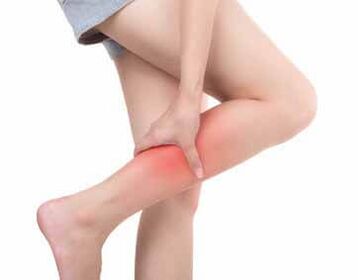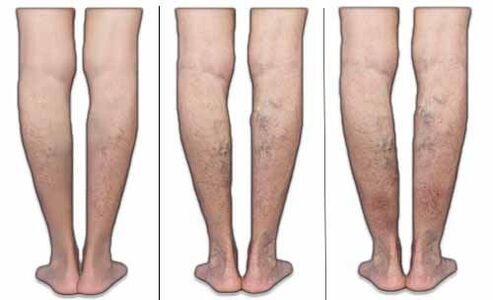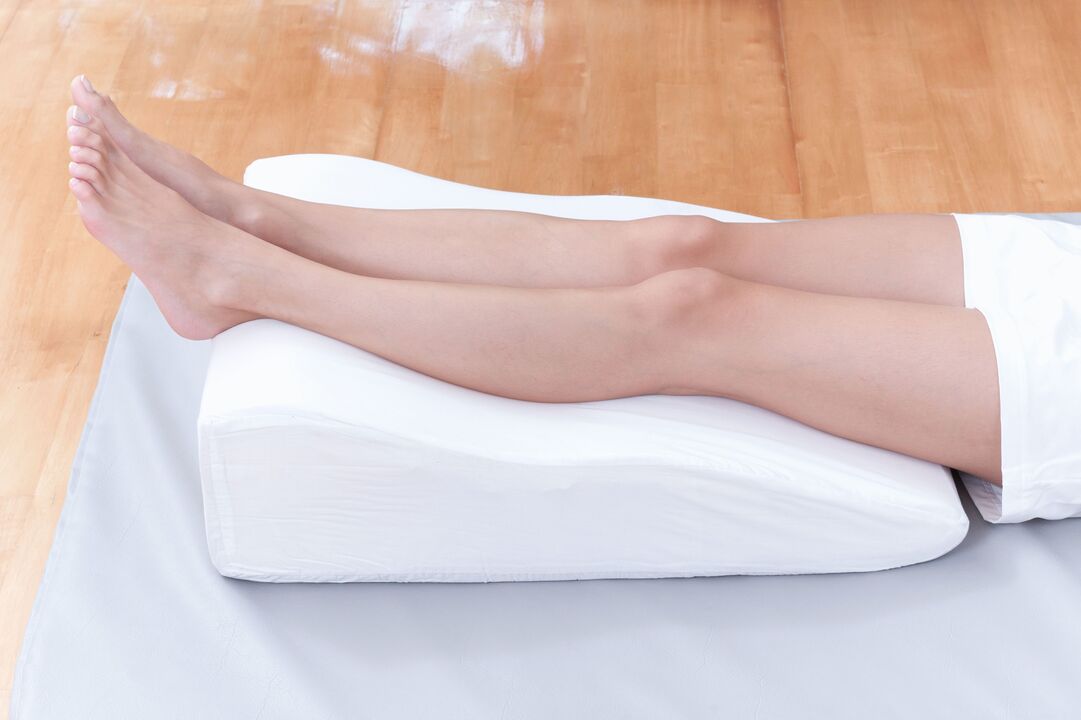Varicosis is a systemic disease that can affect the vessels in any part of the body. Its essence is the malfunction of the valves that control the direction of the blood flow. Because of this, there is a collection of excess volume of fluid in the veins, under the influence of which the walls extend and lose their elasticity.

Most often, medical publications focus on the symptoms and treatment of varicose veins in the foot, as this variety of the disease is considered more common: according to statistics, more than 80% of all cases of varicose veins are precisely in the lower extremities. However, despite this, for most patients, the diagnosis of varicose veins is a surprise, and its detection occurs in the later stages. All this shows people's insufficient awareness of the dangers that carries varicose veins.
Characteristics, causes and mechanism of varicose veins development
The main characteristic of the varicose veins of the legs is its infinity. Changes are subjected to superficial and deep veins at a large length. Since there is a large and long load on the foot, valves in the circulatory system can begin to weaken in childhood. Therefore, detecting varicose veins in the legs often occur in young people and girls.
It is the lower extremities that are characterized by a phenomenon such as hidden varicose veins: against the backdrop of pronounced changes in the veins and unpleasant symptoms, there are no obvious signs of the disease. Therefore, in about one -third of all cases, the disease is detected in advanced stages.
To perform an effective treatment of varicose joints in the legs, the doctor will need to detect the causes of its occurrence. Since even when using radical methods in 80% of patients, varicose veins are restored, special attention should be paid to reduce the effect on the processes of factors provoking varicose veins. These include:
Depending on the location of the veins, doctors distinguish several types of varicose veins in the foot:
Putting the causes of varicose veins and eliminating it is in close relationships. First of all, it is important to exclude factors that have the greatest negative impact on the state of the veins.
When diagnosing venous changes, it is important to distinguish them with other diseases. For example, varicose veins under the knee look just like Becker Cist, and is associated with similar symptoms.

PHASE
The appearance of the first signs of varicose veins in the foot occurs in the progressive stages, when venous valves perform their functions with less than 50%. In the first or zero phase of varicose veins, which is known as a "phase of compensation", there is no discomfort, as well as significant changes. Detection of the initial phase of varicose veins in the foot occurs with a careful examination of the limbs by a phlebologist.
In the second phase of varicose veins, which is known as "subcompensation", changes are well expressed:
This phase of varicose veins of the lower extremities is distinguished by increasing the symptoms, which weaken after rest.
In the last stage of varicose veins, decompensation occurs: the body cannot meet the needs of tissue in oxygen, and the valves in the veins with 90% lose their functions. The condition of the limbs worsens due to insufficient blood supply. This phase of varicose veins is characterized by a decrease in tissue capabilities for regeneration. The abundance of complications exacerbates the general condition of the patient. Symptoms in the final stage of varicose veins are continuously stored.
Symptoms
The most common and early symptom of varicose veins is leg pain until the end of working day. It appears with a change in deep and superficial vessels, and is a signal of insufficient good blood supply to soft tissue. In some cases, pain is the only symptom of varicose veins of the deep veins of the lower extremities. With a change in surface vessels, the appearance of varicose veins in the foot, which often creates only aesthetic disturbances, signals the development of the disease.
The nature of the pain with varicose veins at different stages of the development of the disease may vary:
In addition to obvious physical discomfort, the disease is associated with external changes. Most patients complain that their feet are scratched - with varicose veins, this is considered a normal phenomenon that indicates ischemic processes. A thin varicose grid, which practically does not disturb in the early stages, lasts stronger over time, turning into a thick weaving of thick dishes. Anydo physical activity, including coughing, sneezing or long walking, can lead to a rupture of enlarged capillaries, and sometimes veins. Blood flows under the skin, forming hematomas.
The presence of bruises in the legs with varicose veins indicates a sustainable progression of the disease, excessive stretching and thinning of the veins.
The appearance of red spots on the legs with varicose veins, peeling from the skin, thinning and exposure to damage indicates atrophic processes that are characteristic of the final stages of the disease. Complications are indicated by the rash of the lower leg, which is associated with acute pain and dementia. Such a symptom is characteristic of phlebitis and thrombophlebitis. If the patient is blackened by the foot, this indicates a serious blockage of the veins and the onset of necrotic processes.

Troubleshooting
The ease of diagnosing varicose veins in the foot is exaggerated, as the ships do not always come to the surface. To confirm the diagnosis, the doctor must perform an external examination and perform a number of instrumental research:
To clarify the full appearance of the disease, laboratory studies are described: a coagulogram to assess the risk of thrombosis, a general and biochemical blood test.
Treatment features
Treatment of varicose veins in the leg is engaged in a phleolologist. After determining the degree of pathological changes, the doctor chooses the most effective methods, in his opinion. Unfortunately, it will not work to get rid of varicose veins in the foot forever, as the disease is systematic, and even modern treatment methods give a lasting long -term result, but not 100%.
According to statistics, even after the use of radical methods for the treatment of varicose veins of the lower extremities in 80% of patients, relapse occurs for 5 years.
In the initial stages of varicose veins in the foot, treatment is preferably conservative. Its basis is the use of local and systemic medicines:
With pronounced discomfort for varicose veins in the legs, NSAIDs are described. Preparations of this group help reduce pain, prevent the development of complications.
What to do if itching for varicose legs does not allow you to sleep, do familiar things and make you nervous? It is worth trying ointments or gel with a cooling effect. They will not affect the veins and will not help to cope with the disease, but will quickly relieve the symptom.
In addition to conservative therapy, doctors often use complex treatment methods with varicose veins of the lower extremities, when minimum invasive and surgical surgeries are used simultaneously with medical effects. Such a scheme is used for intense symptoms and wide spread of venous nets. Mass of what measures to take and what to do if the varicose veins in the legs start to progress suddenly, puts a foilist. At the same time, it takes into account all aspects of the development of the disease, individual body characteristics and health problems, which can be contraindications to certain procedures.
What methods are used to eliminate pathological vessels:
Performing surgical or minimum invasive intervention does not mean getting rid of varicose veins. The patient will need to visit a phlebologist regularly, take medication to maintain vein tone and wear compression linen.

Contraindications
Experts attribute contraindications to varicose veins any action that can cause additional stagnation in the lower extremity vessels. These include:
Also, patients should avoid alcohol intake, which helps increase blood viscosity and weakens the walls of blood vessels. Smoking can adversely affect the course of the disease. Therefore, after making a diagnosis, it is necessary to abandon bad habits.
Complications
Thrombosis and inflammatory processes on the vein walls, which were mentioned earlier, is far from the only thing that varicose veins in the legs are dangerous to the patient in terms of complications. Due to circulatory disorders, not only blood vessels, but also soft tissue, therefore, among the consequences of varicose veins in the legs, problems with muscles and skin are mentioned:
Often, with the progression of the disease and excessive extension of the blood vessel walls, the patient risks encountering bleeding from the varicose veins of the lower extremities. It can be as closed when the blood accumulates in the muscles and under the skin and forms hematoma, or open. The second option is filled with a large amount of blood and the arrival of a coma, especially if the patient receives anti -agents and anticoagulants.
This complication of varicose veins of the lower extremities can lead not only to damage but also a minor physical effort, for example, cough or sharp movement.
The most dangerous complications of varicose veins of the lower extremities are pulmonary artery thromboembolism and myocardial infarction. They occur due to the disruption of blood clots in the femur arteries and its migration according to the blood flow system in the coronary and pulmonary vessels. Mortality in such processes is extremely high, so it is important for the patient to always follow well -being and urgently see a doctor with difficulty breathing and dull chest pain.


















